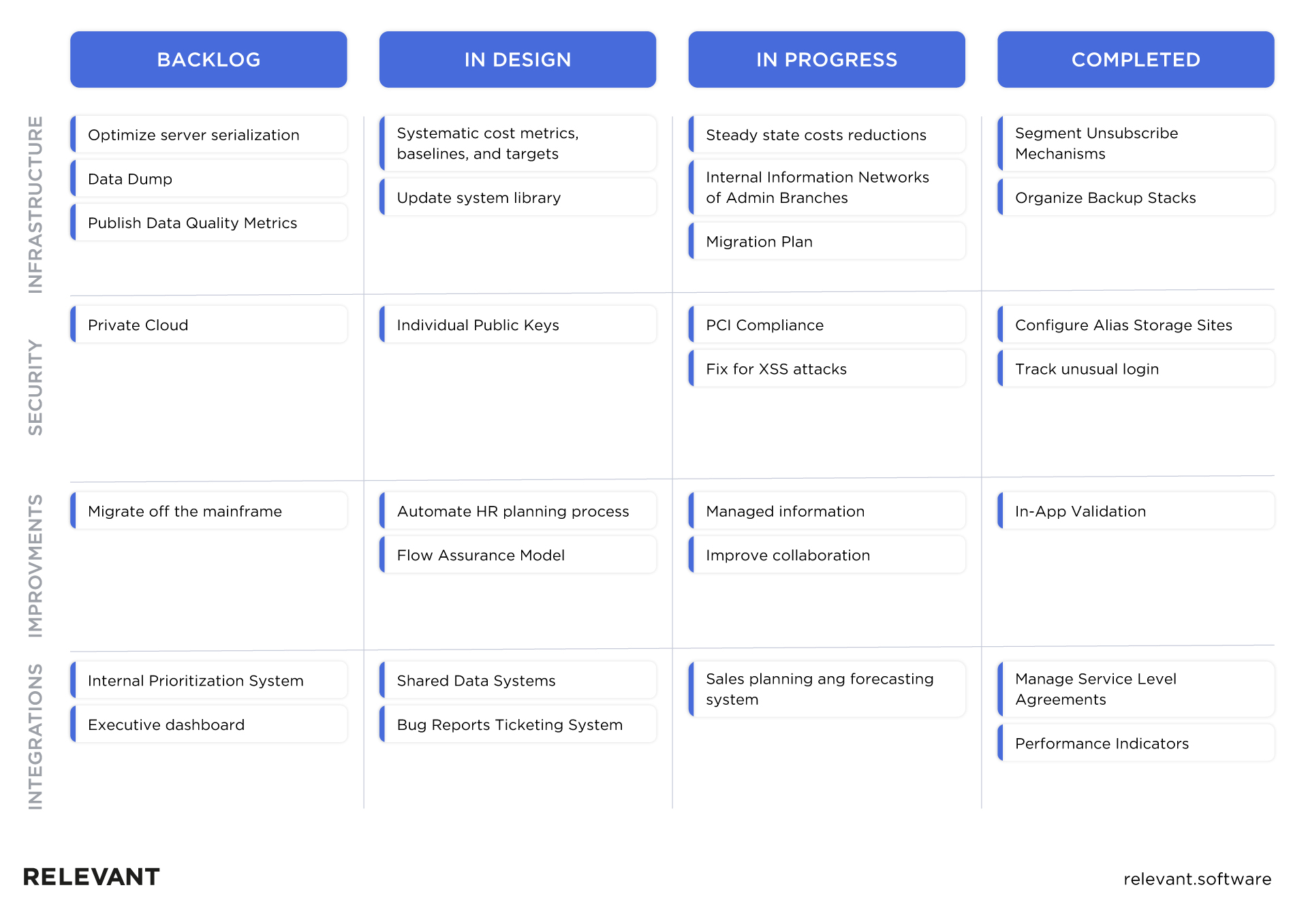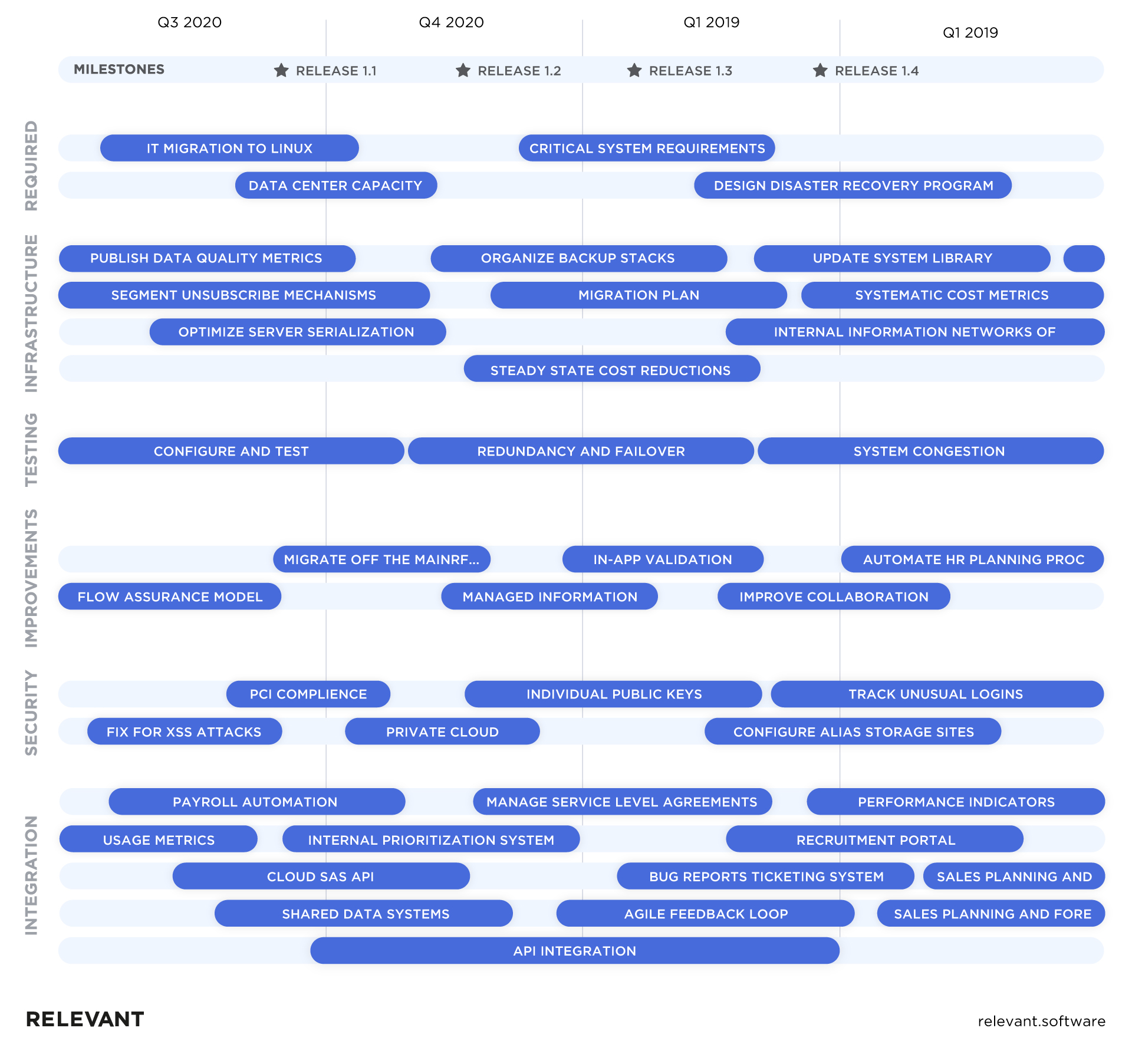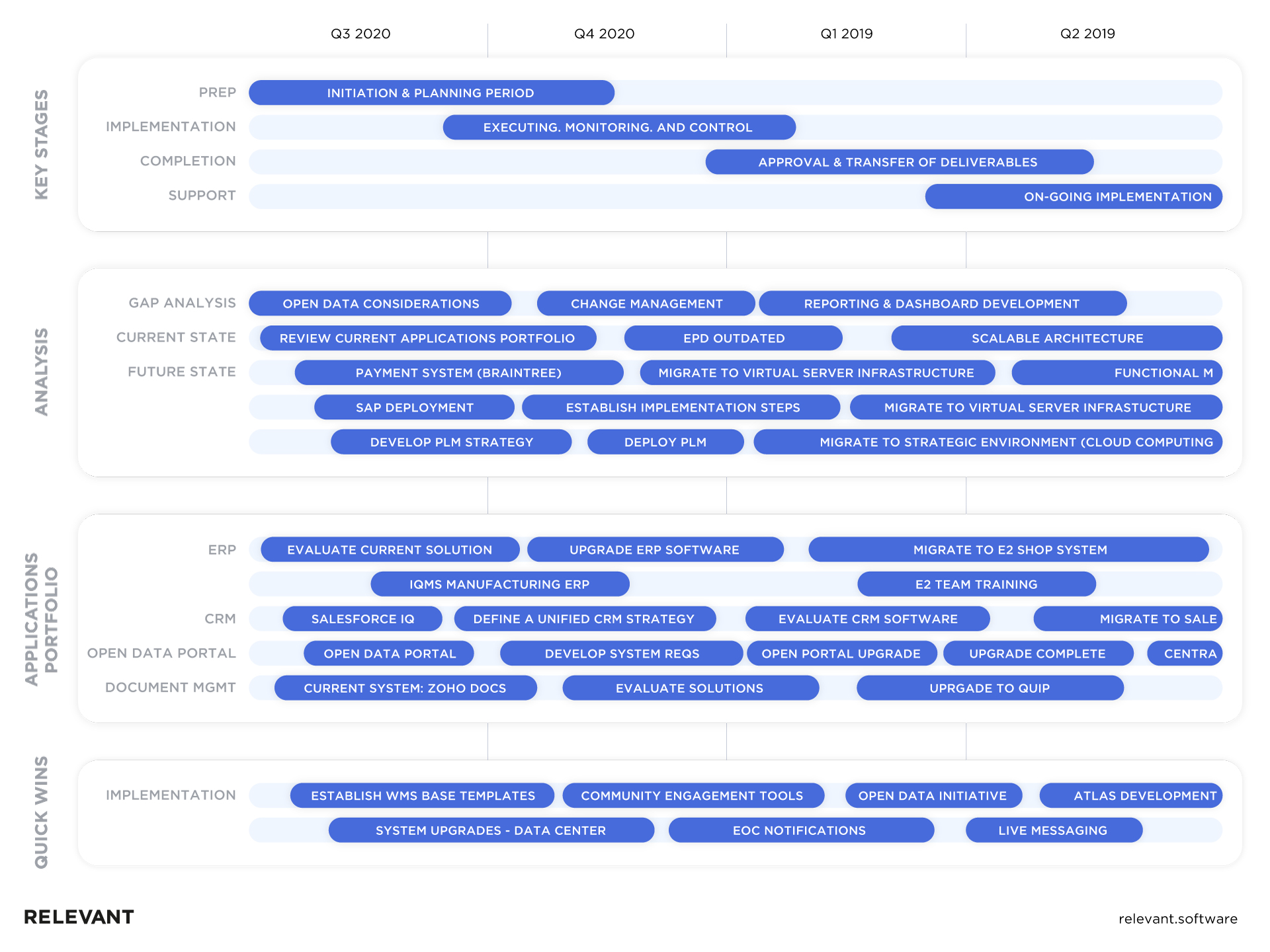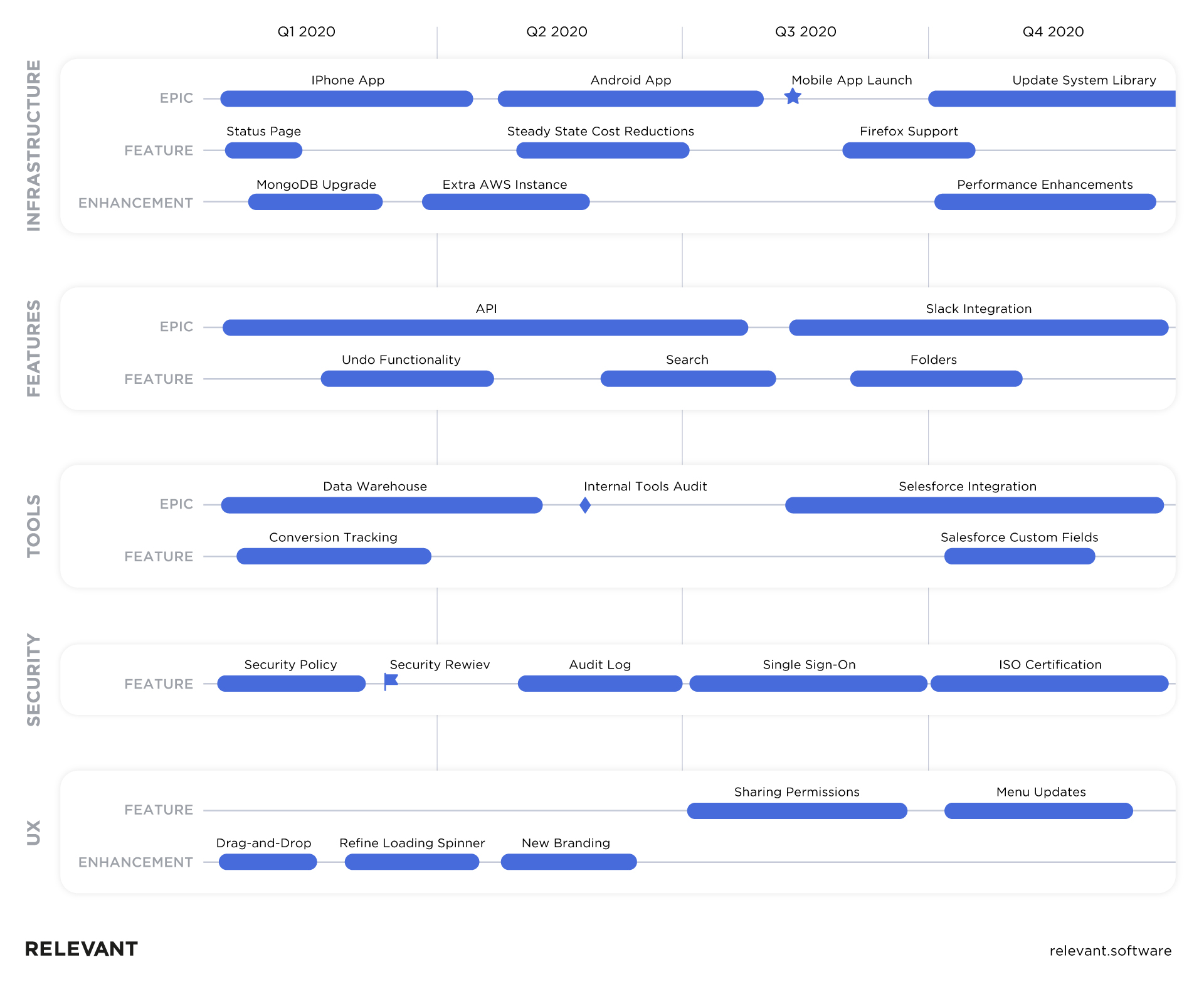Creating Technology Roadmap for the Product: Templates and Examples
Updated: June 7, 2024
Are you a corporate business in need to hit the quarterly revenue quotas and be cost-efficient? Or are you a startup having to ensure maximum profitability of your investments? Be it implementing a feature your competitors have, and you don’t, or ensuring your business’s scalability, a technology roadmap will guarantee that your investments and efforts align with your long-term goals.
Table of Contents
What is a technology roadmap?
Technology roadmap, or an IT roadmap, is an umbrella term with multiple use cases. The most common case is creating an inventory of the tools, systems, and processes used in your organization. This approach helps align the technology stack with the strategic business goals and plan the evolution timeline and milestones that will demonstrate actual improvements.

We provide companies with senior tech talent and product development expertise to build world-class software. Let's talk about how we can help you.
Contact usRoadmaps are usually planned for 18 months in advance and updated at least once a quarter. Technology roadmap depends on the goals you pursue, the unique operational DNA of your business, the way you wish your company to evolve. Thus, there will never be two identical examples of an IT roadmap, despite similar types and templates.
Three types of technology roadmaps
There are three core types of technology roadmaps:
- IT roadmap
- App roadmap
- Dev roadmap.
Let’s take a quick look at their similarities and differences.
IT roadmap
It aims to define how new IT components, whether these are a tool, a process, or a new technology, align with your business strategy and support its growth. This type of roadmap helps answer the following questions:
- What IT initiatives do you plan to implement within a certain timeframe?
- What business objective will these initiatives help achieve?
- How will this improve a business in general?
For example, you want to increase the number of paid subscriptions by 30% this year. One of the simplest ways is converting your free tier users into paid ones. To do so, you should invest in the marketing strategy and implement a better marketing automation system to keep these users in the loop. Your sales and customer support divisions might need a powerful CRM to address new paid customers’ needs and keep them happy; it also might require updating the internal IT systems to ensure you can scale better. Building an IT roadmap is vital to coordinate all of these activities and bring them to fruition.
There are two main technology roadmap modes: Swimlane and Timeline. Swimlane shows all the projects and stages like Backlog, Design, Implementation, and Done, so you can see what is currently happening across your IT ecosystem.

But sometimes, knowing what is done isn’t as important as knowing when it’ll be done. The Timeline view shows the expected delivery time for every IT initiative. However, things happen, so the Timeline roadmap should never be considered a schedule — it’s a somewhat approximate delivery plan with shifting deadlines.

The Timeline’s critical benefit lies in the fact that the time planned to deliver some projects usually roughly represents the number of resources needed to complete it. You can validate the resources devoted to every initiative and relocate them from secondary to primary goals, should the priorities shift.
App roadmap
When starting a business, you need only a handful of tools to run a shop by a single person. However, as the company grows and departments form, the number of apps in use increases. At some point, no tech administrator can remember the full stack of apps your teams work with and why.
An app roadmap is an organization-wide initiative to create a clear picture of the tools currently used and planned for implementation. It helps avoid duplication of resources, minimize the number of unused licenses, and set priorities straight. Mapping out what to upgrade and when helps keep your stakeholders up to speed.

Dev roadmap
Software is eating the world, and as a decade ago, this statement doesn’t lose a bit of meaning. Most likely, your business communicates with its customers online and provides some products or services on the internet. To be useful and profitable, these products and services must be developed, released, and updated, and dev roadmap helps oversee this situation.
However, business stakeholders shouldn’t pay attention to every detail of every sprint. The dev roadmap isn’t a project management control panel with all the tasks, deadlines, bug reports, etc. It’s more of a high-level overview of the team’s product development priorities, so the managers can quickly grasp when to expect the release of a shiny new feature and coordinate the work of other departments accordingly.

Benefits of having a technology roadmap
There are several essential advantages of drafting a technology roadmap, and they fit for any business, large and small.
Becoming and staying competitive
Every market is competitive, and competing by price tag alone doesn’t work anywhere outside of grocery stores. Most outstanding businesses offer unique features or customer experience based on technology their competitors don’t provide. The roadmap helps highlight the time and resources needed to implement the latest technology and stay ahead of the market.
Uber is a great example. It disrupted the transportation market by allowing any driver to earn extra cash and any passenger to get to their destination in a luxury car instead of a cab. This result was achieved by launching a user-friendly mobile app, while the rest of the market offered only a callback option. Now, almost every taxi service has a mobile app, but Uber has already made a considerable profit.
Ability to predict IT expenses
A roadmap shows the approximate timeline for rolling out new features, processes, and tools, and, therefore, can highlight upcoming expenses. Of course, the hardware can still unexpectedly fail and cost you in operational spending and data value, unless you have replication in place and planned for contingency and failover. However, while unplanned expenses can happen, knowing when to expect predictable investments helps plan the IT budget better.
Smooth transition to the cloud
If your business is cloud-native, a question “to cloud or not to cloud” should not bother you. But if you’re still using mainframe systems or dedicated servers, as most companies do, cloud migration is a hot thing. Still, the transition to the cloud can render your business infrastructure inoperable if planned and executed poorly. Technology roadmap helps note and keep track of multiple steps for your cloud journey to succeed.
Regulatory & compliance fit
Roadmaps help prepare for any regulatory and compliance changes your company must undergo.
Ability to attract better IT talent faster
Having a structured plan of IT systems evolution helps predict the need for new talent. This way, your HR and talent acquisition department can start looking for the right candidates long before they are needed. And you can get the best fits, not just someone to put out a fire that has been burning for half a year already. Speaking of which…
Putting out the fires
To continually remind of the problem your department faces and to show how it affects the rest of the organization is a whole different beast. The technology roadmap helps highlight the crucial challenges for every company and dedicate sufficient resources to solve them timely. By the way, about the appropriate solution…
Using employee time efficiently
The roadmap underscores mid- and long-term business objectives and draws your employees’ attention to it. Instead of doing routine tasks that can be automated, which is the roadmap’s most urgent priority, it’ll free up employee’s time to achieve goals that matter.
Improved relations between all business parts
Many companies consider their IT departments processual bottlenecks and money wasters. At the same time, they should be the drivers of tech innovation to make the business more productive. Technology roadmap helps align the business goals and IT initiatives to improve interdepartmental communication, show how and when the needs will be addressed, explain why some tasks take so much time. Spoiler alert: it’s most likely not due to IT being pricks, it’s because they need to do something else first to fulfill your request.
How to design and plan a technology roadmap
As mentioned above, there’ll never be two exactly matching roadmaps, as they depend on a variety of factors. For example, scaling your business up or down entails two different approaches:
- Scaling down in times of crisis aims to save as much operational infrastructure as possible to avoid critical losses. To that end, the IT roadmap helps evaluate the importance of your IT assets and initiatives and shows where to concentrate efforts.
- Scaling up is quite different, as you should focus on building a strong basis for continuous growth. The ways to achieve this goal will differ depending on your industry, company type, product maturity stage, etc. The intention here is to address the unique challenges you face and maximize the potential profits.
Once the direction of your company evolution is selected, the rest of the steps are pretty straightforward.
Base your decisions on data
Guessing is medieval. In the 21st century, an IT director has a wealth of data at their disposal:
- Historical data on gross and net revenues — monthly, quarterly, annual
- Financial estimates for the next year or so
- Resource usage statistics
- Current data storage capacity, the velocity of intake and expected term till exceeding this capacity
- Current infrastructure speed and performance.
This list isn’t exhaustive, and other business stakeholders can add to it. Creating an IT roadmap aims to set a productive dialogue between all business units and ensure the IT goals are in line with the company ones.
Designing a roadmap: describe what you plan to reach
A roadmap is essentially a timeline, where to the left, you have your current IT situation, and to the right, the target you want to reach in 18 months. Break these long-term goals into shorter tasks, assign them to responsible people — and there you have it! To succeed with your IT roadmap, you have actually to consider multiple factors:
- Mergers & acquisitions. Whether your company will become a part of a bigger structure or inherit the digital assets of a lesser partner, your technology roadmap must be adjusted.
- Research for alternatives. The SaaS market is continuously evolving, and the tool that was creme de la creme a year ago might now be moot. Thus, before starting with a goal set 18 months ago, test the current waters and study alternatives. That’s why quarterly revisions of a roadmap are useful to keep its goals aligned to the business strategy.
- Policies and procedures. Do you have an automated disaster recovery solution? Will the customers request it in the nearest future? Answering such questions is hugely beneficial to instate the policies and procedures that affect all of your workflows.
- Scalability. The roadmap must be built with scalability in mind, and it must be the priority during regular revisions. Are you pushing the toolset over its scalability limits? Maybe it’s time to replace the tools that don’t scale well?
- Working with external consultants. Many businesses opt for external consultants to avoid mistakes. Whether you employ them to assess the current infrastructure or delegate some ad-hoc tasks, this can drive improved outcomes across the roadmap. However, look for credible certifications, a broad set of supported technologies, and clear communication to ensure you get the most value.
Technology roadmap examples
It all sounds great, but what about the actual examples? Take a look at these:
- Unlike traditional roadmaps, an IT roadmap from the University of Michigan is a curve that explains what services are currently supported, which ones will soon be retired, what they will be replaced with — and why.
- This strategic overview of the organization’s goals and relevant IT initiatives showcases a simple way to highlight what goals are at risk.
- This Product roadmap example from Stanford University emphasizes the plans and efforts dedicated to managing and updating its internal product.
As you can see, roadmaps shouldn’t be covering all the aspects of every process in fine detail. They are high-level strategic overviews that show the general direction of evolution for your company’s IT initiatives.
Best tools for creating a technology roadmap
It’s natural to want to have your roadmap management solutions combined with project management apps. After all, this simplifies minute task tracking and progress monitoring and provides easy access to the history of analytics. That’s why the most popular project management platforms come with built-in roadmap management features:
- Aha!
- Asana
- Confluence
- Monday
- Microsoft Flow
- ProductBoard
- ProductPlan
- Roadmunk
- Targetprocess
- Trello
- Wrike
All these tools enable you to devise and manage the technology roadmap for your organization, while also monitoring the completion of the projects it consists of. Experiment with free versions to find what fits your needs best.
Summary
To wrap it up, creating a technology roadmap for your product, the IT department, or the entire business is quite doable. Base it on your estimates regarding future company scale, make data-driven decisions based on input from all key stakeholders, and review the roadmap regularly to ensure the goals are relevant and align with the business strategy.
If this sounds too complicated or you don’t want to delve deep in the roadmap management — consider working with reliable consultants. At Relevant Software, we have delivered over 200 software projects and have solid experience in planning and following all kinds of roadmaps. Should you want to tap into that expertise — let us know. We’re always glad to assist!
Our core services:
Do you want a price estimate for your project?
Do you know that we helped 200+ companies build web/mobile apps and scale dev teams?
Let's talk about your engineering needs.
Write to us











